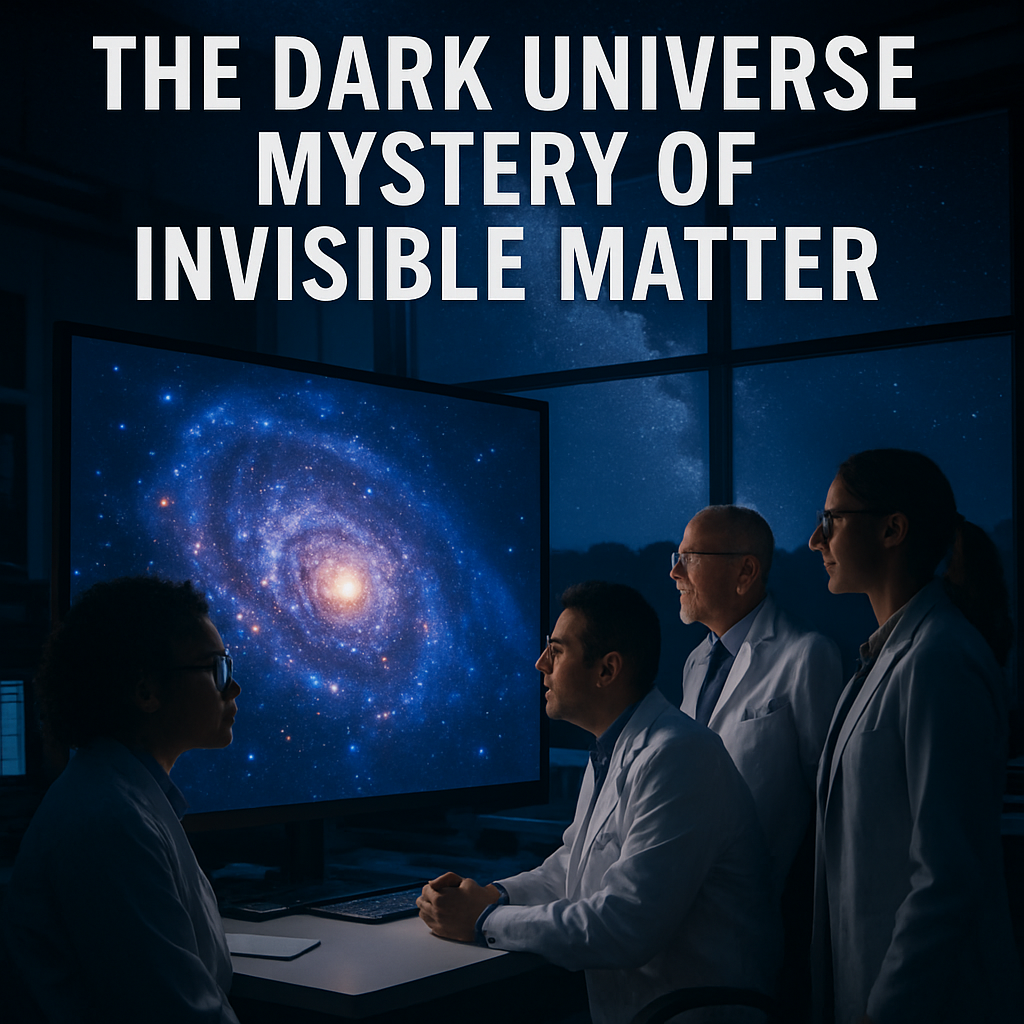The Dark Universe Mystery of Invisible Matter

Looking up at the night sky, we see countless stars and galaxies, but what we observe represents just a tiny fraction of what’s actually out there. Scientists have discovered that roughly 95% of our universe consists of substances we can’t directly see or interact with. This “dark universe” – comprising dark matter and dark energy – represents one of the most profound mysteries in modern cosmology.
The Unseen Majority
Imagine walking through a crowded room where you can only see 5% of the people. You’d bump into invisible obstacles, witness objects moving seemingly on their own, and struggle to make sense of what’s happening. That’s essentially the predicament astronomers face when studying the cosmos.
Dark matter makes up about 27% of the universe, while visible matter – the stuff we can actually see – accounts for a mere 5%. The remaining 68% consists of dark energy, an even more mysterious force driving the accelerated expansion of the universe.
But how did scientists come to propose the existence of something they can’t directly observe? The story begins in the 1930s with Swiss astronomer Fritz Zwicky. While studying the Coma Cluster, a group of galaxies approximately 321 million light-years from Earth, Zwicky noticed something odd. The galaxies were moving much faster than expected based on the visible mass present. By all accounts, they should have been flying apart, yet they remained gravitationally bound together.
Zwicky proposed that some invisible “dunkle materie” (dark matter) must be providing the extra gravitational pull. Most astronomers dismissed his idea at the time, but decades later, Vera Rubin’s observations of galaxy rotation curves provided compelling evidence that Zwicky was right.
When astronomers measure how quickly stars orbit around the centers of spiral galaxies, they find that stars at the outer edges move much faster than Newton’s laws predict based on visible matter alone. Without some additional mass providing gravitational pull, these galaxies should literally tear themselves apart.
“The stars in the outer regions of galaxies were moving so fast that they should have escaped the galaxies’ gravitational pull,” explains Dr. Katherine Freese, theoretical astrophysicist at the University of Michigan. “The fact that they didn’t escape meant that some unseen mass was holding them in.”
Other evidence for dark matter comes from gravitational lensing – the bending of light as it passes through strong gravitational fields. When astronomers observe distant galaxies, they sometimes see multiple images or distorted arcs of the same galaxy, caused by massive objects bending light rays as they travel toward Earth. These observations consistently show more gravitational lensing than visible matter can account for.
Perhaps the most striking example is the Bullet Cluster, where two galaxy clusters collided. Observations show that the visible matter (primarily hot gas) slowed down during the collision, while the gravitational centers of the clusters passed right through each other. This separation between visible mass and gravitational influence provides some of the strongest evidence for dark matter’s existence.
The Hunt for the Invisible
If dark matter exists, what exactly is it? Scientists have proposed numerous candidates, but none have been definitively confirmed.
The leading contenders are Weakly Interacting Massive Particles (WIMPs) – hypothetical particles that barely interact with ordinary matter except through gravity and possibly the weak nuclear force. These particles would have been produced in abundance during the Big Bang and would now form halos around galaxies.
Another possibility is Axions – extremely light particles originally proposed to solve problems in quantum chromodynamics (the theory of the strong nuclear force). If they exist, axions would have been produced abundantly in the early universe and could account for dark matter.
More exotic possibilities include primordial black holes, sterile neutrinos, or modifications to our understanding of gravity itself. The Modified Newtonian Dynamics (MOND) theory, for instance, suggests that Newton’s laws of gravity need revision at very large scales, potentially eliminating the need for dark matter entirely.
Scientists are pursuing multiple approaches to detect dark matter particles directly. Deep underground, detectors like XENON1T at Italy’s Gran Sasso National Laboratory and LUX-ZEPLIN in South Dakota use tanks of liquid xenon to try catching rare interactions between dark matter particles and normal atoms. When a dark matter particle collides with a xenon nucleus, it should produce a tiny flash of light and a few ionized electrons.
“These experiments are extraordinarily sensitive,” says Dr. Rafael Lang, physicist at Purdue University. “We’re looking for interactions so rare that they might happen once per year in a detector containing tons of material.”
So far, these direct detection experiments haven’t found conclusive evidence of dark matter particles. Every few years, an experiment reports a possible signal, generating excitement, but follow-up studies typically fail to confirm the findings.
Particle accelerators like the Large Hadron Collider (LHC) offer another approach. By smashing particles together at nearly the speed of light, physicists hope to create dark matter particles in the laboratory. If dark matter exists in the form of WIMPs, the LHC might be able to produce them, identified by “missing energy” in collision events.
I’ve talked with several physicists who’ve dedicated their careers to this search. Many admit feeling frustrated by the lack of direct detection, yet remain convinced that dark matter particles exist. “Sometimes I wonder if we’re missing something fundamental,” a colleague at MIT told me during a conference last year. “But then I look at all the astronomical evidence, and it’s hard to escape the conclusion that something’s out there.”
Beyond Dark Matter
As if dark matter weren’t mysterious enough, dark energy presents an even bigger puzzle. This strange force appears to be driving the accelerated expansion of the universe, essentially working against gravity.
The discovery of dark energy came in 1998 when two independent teams of astronomers were measuring the expansion rate of the universe using Type Ia supernovae as “standard candles” – explosions with known brightness that allow scientists to calculate their distance. Both teams expected to find that the expansion was slowing down due to gravity. Instead, they found the opposite: the universe’s expansion is accelerating.
This shocking discovery, which earned the 2011 Nobel Prize in Physics, suggested that some unknown force is pushing the universe apart faster and faster. Scientists named this force “dark energy.”
What could dark energy be? The simplest explanation is Einstein’s cosmological constant – a form of energy inherent to space itself. As the universe expands, creating more space, it also creates more dark energy, accelerating the expansion further.
Alternative explanations include quintessence (a dynamic field that changes over time) or modifications to Einstein’s theory of general relativity. Some physicists even question whether dark energy exists at all, suggesting that our understanding of supernovae or cosmic distance measurements might be flawed.
The implications of dark energy extend to the ultimate fate of our universe. If dark energy continues to dominate, the universe will expand forever, eventually becoming cold and diffuse. Galaxies beyond our local group will accelerate away from us, eventually becoming invisible as they recede faster than light can travel toward us. In the extremely distant future, observers would see only their own galaxy, with all evidence of the broader universe gone – a sobering thought.
Dark matter and dark energy represent humbling reminders of how much we still don’t understand about the universe. Despite all our technological advances and mathematical models, 95% of the cosmos remains hidden from direct observation.
Yet this mystery also drives scientific progress. New telescopes like the Vera C. Rubin Observatory and the James Webb Space Telescope will provide unprecedented views of cosmic structure and evolution, potentially offering new insights into the dark universe. Meanwhile, next-generation particle detectors and accelerators continue the direct search for dark matter particles.
Perhaps the most exciting possibility is that solving these mysteries will require entirely new physics – frameworks that go beyond our current understanding of particles and forces. Just as Einstein’s relativity superseded Newtonian physics, the dark universe may lead us to deeper truths about reality itself.
For now, we continue gazing at the stars, knowing that what we see is merely the tip of a vast cosmic iceberg, with most of the universe’s mass and energy hidden from view. The search continues, driven by that most fundamental human trait – curiosity about the unknown.


